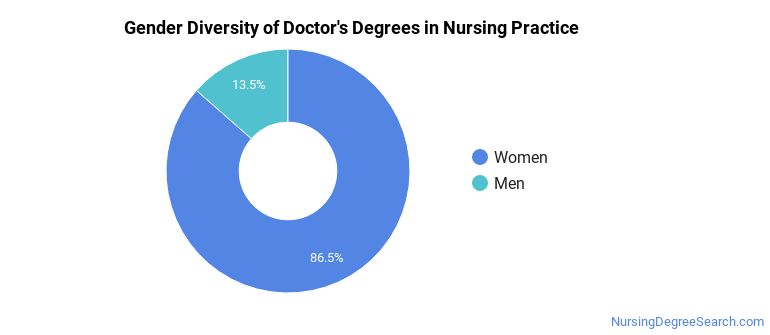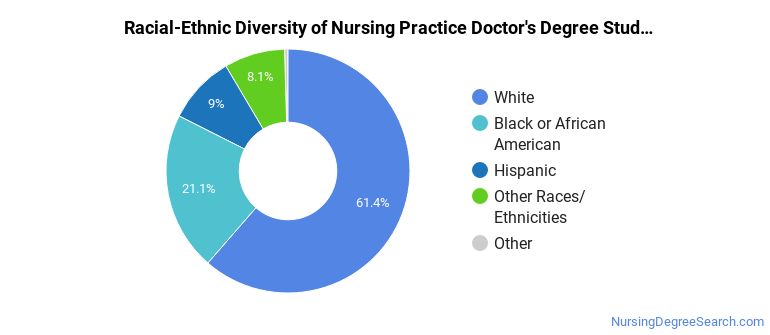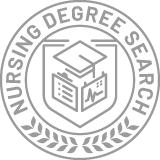Doctor’s Degrees in Nursing Practice
Education Levels of Nursing Practice Majors
During the most recent year for which data is available, 7,474 people earned their doctor's degree in nursing practice. This earns it the #1 spot on the list of the most popular doctor's degree programs in the nation.
The following table shows the number of diplomas awarded in nursing practice at each degree level.
| Education Level | Number of Grads |
|---|---|
| Doctor’s Degree | 7,474 |
| Bachelor’s Degree | 832 |
| Master’s Degree | 453 |
| Graduate Certificate | 275 |
| Associate Degree | 161 |
| Basic Certificate | 19 |
| Undergraduate Certificate | 2 |
Earnings of Nursing Practice Majors With Doctor’s Degrees
At this time, we do not have the data to estimate the median earnings for this class of people.
Student Debt
The data on debt ranges for nursing practice majors who have their doctor's degree is not available.
Student Diversity
More women than men pursue their doctor's degree in nursing practice. About 86.5% of graduates with this degree are female.
| Gender | Number of Grads |
|---|---|
| Men | 1,011 |
| Women | 6,463 |

The racial-ethnic distribution of nursing practice doctor’s degree students is as follows:
| Race/Ethnicity | Number of Grads |
|---|---|
| Asian | 543 |
| Black or African American | 1,459 |
| Hispanic or Latino | 627 |
| White | 4,255 |
| International Students | 31 |
| Other Races/Ethnicities | 559 |

Most Popular Nursing Practice Programs for Doctor’s Degrees
There are 297 colleges that offer a doctor’s degree in nursing practice. Learn more about the most popular 20 below:
The most popular school in the United States for nursing practice students seekinga doctor's degree is Chamberlain University - Illinois. Roughly 29,400 attend the school each year. The average in-state tuition for full-time undergraduates is $19,341 per year, while in-state graduate students, on average, pay $13,650 per year. During the most recent year for which we have data, 565 people received their doctor's degree in nursing practice from Chamberlain - Illinois. Around 54% of these students were from an underrepresented racial-ethnic group, and 91% were women.
Grand Canyon University comes in at #2 on our list of the most popular colleges offering doctor's degrees in nursing practice. Roughly 103,400 attend the school each year. The average in-state tuition for full-time undergraduates is $16,390 per year, while in-state graduate students, on average, pay $10,138 per year. During the most recent year for which we have data, 368 people received their doctor's degree in nursing practice from Grand Canyon University. About 91% of this group were women, and 64% were students from an underrepresented racial-ethnic group.
Rush University comes in at #3 on our list of the most popular colleges offering doctor's degrees in nursing practice. Roughly 2,800 attend the school each year. The average in-state tuition for full-time undergraduates is $30,957 per year, while in-state graduate students, on average, pay $38,013 per year. During the most recent year for which we have data, 196 people received their doctor's degree in nursing practice from Rush University. Around 20% of these students were from an underrepresented racial-ethnic group, and 88% were women.
Columbia University in the City of New York is the 6th most popular school in the nation for students seeking a doctor's degree in nursing practice. Each year, around 30,100 students seeking various degrees attend the university. The average in-state tuition for full-time undergraduates is $64,526 per year, while in-state graduate students, on average, pay $53,576 per year. During the most recent year for which we have data, 140 people received their doctor's degree in nursing practice from Columbia. Around 50% of these students were from an underrepresented racial-ethnic group, and 90% were women.
University of Maryland - Baltimore is the 7th most popular school in the nation for students seeking a doctor's degree in nursing practice. Each year, around 7,100 students seeking various degrees attend the university. The average in-state tuition for full-time undergraduates is $9,827 per year, while in-state graduate students, on average, pay $15,750 per year. During the most recent year for which we have data, 133 people received their doctor's degree in nursing practice from UMB. Around 40% of these students were from an underrepresented racial-ethnic group, and 87% were women.
University of Illinois at Chicago comes in at #8 on our list of the most popular colleges offering doctor's degrees in nursing practice. Roughly 33,500 attend the school each year. The average in-state tuition for full-time undergraduates is $12,656 per year, while in-state graduate students, on average, pay $14,108 per year. During the most recent year for which we have data, 123 people received their doctor's degree in nursing practice from UIC. Of these students, 93% were women and 35% were members of underrepresented racial-ethnic groups.
University of Arizona is the 9th most popular school in the nation for students seeking a doctor's degree in nursing practice. Roughly 45,600 attend the school each year. The average in-state tuition for full-time undergraduates is $11,546 per year, while in-state graduate students, on average, pay $12,718 per year. During the most recent year for which we have data, 94 people received their doctor's degree in nursing practice from University of Arizona. Of these students, 83% were women and 39% were members of underrepresented racial-ethnic groups.
University of Alabama at Birmingham comes in at #10 on our list of the most popular colleges offering doctor's degrees in nursing practice. Roughly 22,500 attend the school each year. The average in-state tuition for full-time undergraduates is $8,832 per year, while in-state graduate students, on average, pay $8,424 per year. During the most recent year for which we have data, 92 people received their doctor's degree in nursing practice from UAB. About 80% of this group were women, and 26% were students from an underrepresented racial-ethnic group.
University of North Carolina at Greensboro comes in at #11 on our list of the most popular colleges offering doctor's degrees in nursing practice. Each year, around 19,700 students seeking various degrees attend the university. The average in-state tuition for full-time undergraduates is $4,422 per year, while in-state graduate students, on average, pay $5,375 per year. During the most recent year for which we have data, 83 people received their doctor's degree in nursing practice from UNC Greensboro. Around 30% of these students were from an underrepresented racial-ethnic group, and 81% were women.
Northern Kentucky University is the 12th most popular school in the nation for students seeking a doctor's degree in nursing practice. Roughly 16,200 attend the school each year. The average in-state tuition for full-time undergraduates is $10,512 per year, while in-state graduate students, on average, pay $10,206 per year. During the most recent year for which we have data, 82 people received their doctor's degree in nursing practice from NKU. Around 28% of these students were from an underrepresented racial-ethnic group, and 85% were women.
The 13th most popular school in the country for nursing practice majors who are seeking their doctor's degree is Florida International University. Each year, around 58,800 students seeking various degrees attend the university. The average in-state tuition for full-time undergraduates is $4,721 per year, while in-state graduate students, on average, pay $9,119 per year. During the most recent year for which we have data, 80 people received their doctor's degree in nursing practice from FIU. Around 75% of these students were from an underrepresented racial-ethnic group, and 72% were women.
Arizona State University - Tempe comes in at #14 on our list of the most popular colleges offering doctor's degrees in nursing practice. Roughly 74,700 attend the school each year. The average in-state tuition for full-time undergraduates is $11,308 per year, while in-state graduate students, on average, pay $12,376 per year. During the most recent year for which we have data, 77 people received their doctor's degree in nursing practice from ASU - Tempe. Around 33% of these students were from an underrepresented racial-ethnic group, and 95% were women.
University of North Florida is the 15th most popular school in the nation for students seeking a doctor's degree in nursing practice. Each year, around 16,900 students seeking various degrees attend the university. The average in-state tuition for full-time undergraduates is $3,996 per year, while in-state graduate students, on average, pay $8,570 per year. During the most recent year for which we have data, 73 people received their doctor's degree in nursing practice from UNF. Around 47% of these students were from an underrepresented racial-ethnic group, and 89% were women.
University of Florida comes in at #16 on our list of the most popular colleges offering doctor's degrees in nursing practice. Roughly 53,300 attend the school each year. The average in-state tuition for full-time undergraduates is $4,477 per year, while in-state graduate students, on average, pay $10,770 per year. During the most recent year for which we have data, 71 people received their doctor's degree in nursing practice from UF. About 87% of this group were women, and 37% were students from an underrepresented racial-ethnic group.
Southern Illinois University Edwardsville is the 17th most popular school in the nation for students seeking a doctor's degree in nursing practice. Roughly 12,800 attend the school each year. The average in-state tuition for full-time undergraduates is $8,846 per year, while in-state graduate students, on average, pay $7,700 per year. During the most recent year for which we have data, 69 people received their doctor's degree in nursing practice from SIUE. About 88% of this group were women, and 23% were students from an underrepresented racial-ethnic group.
Louisiana State University Health Sciences Center - New Orleans is the 17th most popular school in the nation for students seeking a doctor's degree in nursing practice. Roughly 2,800 attend the school each year. The average in-state tuition for full-time undergraduates is $7,020 per year, while in-state graduate students, on average, pay $11,835 per year. During the most recent year for which we have data, 69 people received their doctor's degree in nursing practice from LSU Health - New Orleans. Around 25% of these students were from an underrepresented racial-ethnic group, and 68% were women.
The 19th most popular school in the country for nursing practice majors who are seeking their doctor's degree is The University of Tennessee - Health Science Center. Roughly 3,100 attend the school each year. The average in-state tuition for full-time undergraduates is $9,489 per year, while in-state graduate students, on average, pay $13,167 per year. During the most recent year for which we have data, 68 people received their doctor's degree in nursing practice from UTHSC. Of these students, 79% were women and 34% were members of underrepresented racial-ethnic groups.
The 20th most popular school in the country for nursing practice majors who are seeking their doctor's degree is University of Massachusetts Amherst. Each year, around 31,600 students seeking various degrees attend the university. The average in-state tuition for full-time undergraduates is $16,591 per year, while in-state graduate students, on average, pay $14,723 per year. During the most recent year for which we have data, 54 people received their doctor's degree in nursing practice from UMass Amherst. About 86% of this group were women, and 38% were students from an underrepresented racial-ethnic group.
Explore Major by State
Alabama
Arkansas
Connecticut
Florida
Idaho
Iowa
Louisiana
Massachusetts
Mississippi
Nebraska
New Jersey
North Carolina
Oklahoma
Rhode Island
Tennessee
Vermont
West Virginia
Related Majors
Below are some popular majors that are similar to nursing practice that offer doctor’s degrees.
| Major | Annual Degrees Awarded |
|---|---|
| Nurse Anesthetist | 1,403 |
| Registered Nursing | 976 |
| Nursing Science | 927 |
| Nursing Administration | 725 |
| Family Practice Nursing | 683 |
References
*The racial-ethnic minority student count is calculated by taking the total number of students and subtracting white students, international students, and students whose race/ethnicity was unknown. This number is then divided by the total number of students at the school to obtain the percentage of racial-ethnic minorities.
- College Factual
- National Center for Education Statistics
- O*NET Online
- Bureau of Labor Statistics
- Image Credit: By Aleksahgabrielle under License
More about our data sources and methodologies.
















